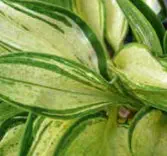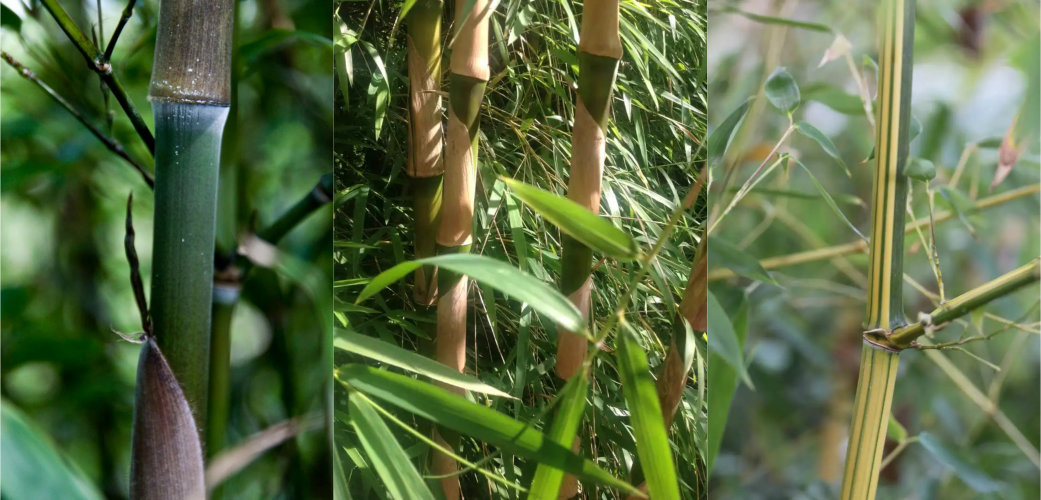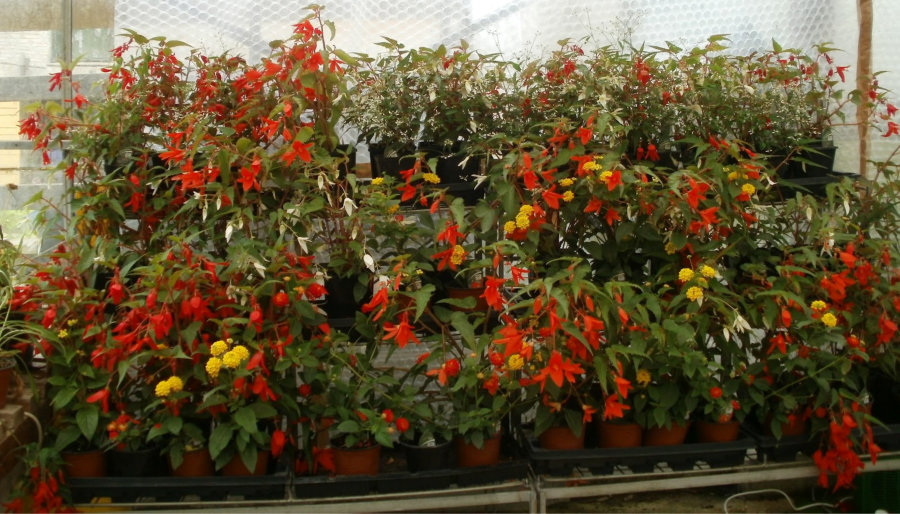A range of leaf colours and patterns makes variegated hostas among the most diverse of foliage plants
Hostas have become such popular herbaceous foliage plants in UK gardens because of their versatility, diversity of size and leaf shape and, in the case of variegated cultivars, the range of colours and patterning. With more than 3,000 registered cultivars a huge choice is available, whether for growing in the open garden or in containers. While some will excel in full sun given enough moisture, many are best known for their excellent performance in shade.
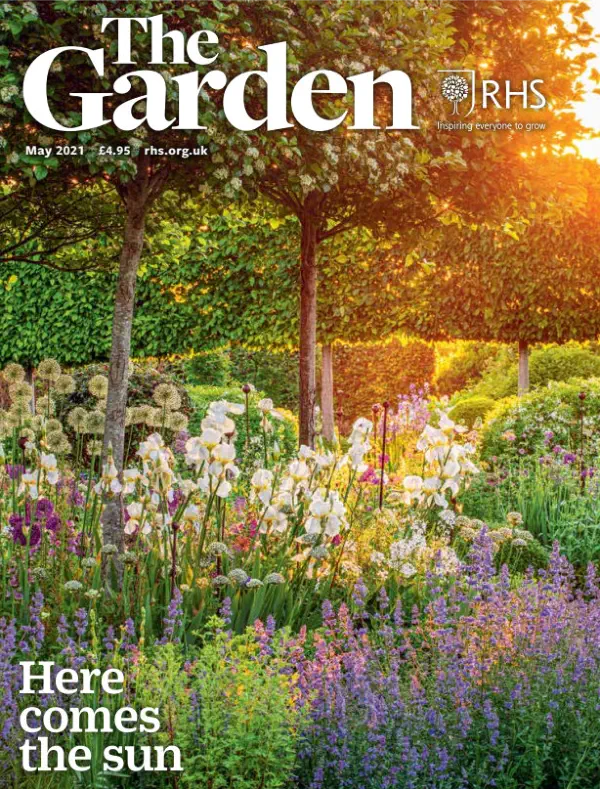 Variegation in hostas is perhaps their biggest draw, with one of the widest ranges of patterning and colour seen in any plant group. Hostas will take a wide range of growing situations from sun to full shade. When selecting them, follow the rule that if you want one for a sunny spot, darker foliage is best suited and really pale or heavy variegation may scorch or wilt. Lighter foliage, however, is useful for bringing cheer and brightness to duller areas in the garden. Hosta ‘Sea Thunder’ always performs well in shade, and as one of the first hostas to emerge, it always gladdens my heart with its announcement that spring is well on its way.
Variegation in hostas is perhaps their biggest draw, with one of the widest ranges of patterning and colour seen in any plant group. Hostas will take a wide range of growing situations from sun to full shade. When selecting them, follow the rule that if you want one for a sunny spot, darker foliage is best suited and really pale or heavy variegation may scorch or wilt. Lighter foliage, however, is useful for bringing cheer and brightness to duller areas in the garden. Hosta ‘Sea Thunder’ always performs well in shade, and as one of the first hostas to emerge, it always gladdens my heart with its announcement that spring is well on its way.
Compact and bijou choices
Tiny and miniature hostas, those with leaves 5cm (2in) across or less on plants only 10–50cm (4–20in) in height and spread, are ideal for shallow pots and small spaces. In fact, they are best not grown in mixed borders, where they can be overwhelmed by larger, more vigorous plants. The cultivars ‘Toy Soldier’ AGM 2 , ‘Baby Booties’ 13 , ‘Deliverance’ 7 , ‘Kalamazoo’ 5 and ‘Electrocution’ 12 are well suited for making eye-catching potfuls. Hosta ‘Mini Skirt’ 16 , with its wavy edges and wide cream margins, is most useful in a semi-shaded spot, whereas ‘Allan P McConnell’ AGM 8 , with its dark green centres and thin margins of almost white, works well in a pot in sun.
Giving a home to Hosta
Easy-to-grow herbaceous plants grown primarily for their broad foliage.
Family: Asparagaceae.
Introduction: Great foliage plants for borders and pots; a huge range of sizes, leaf colours and patterns from white through yellow and green to blue.
In the garden: Particularly good in shade, but some cultivars will take full sun given enough moisture.
Growing requirements: Prefer moist to heavy, fertile soils and loam-based potting composts; unfussy as to pH.
RHS hardiness rating: Most cultivars H7: hardy in the most severe winters (colder than −20°c/−4°F).
Propagation: Easy by division for named cultivars in spring or autumn.
Pests and diseases: Mainly slugs and snails
Medium-sized options
This group covers the bulk of hosta cultivars, with plants forming clumps from 50cm (20in) to 1m (39in) or more in height and spread. They are more suited to general planting in borders where they can hold their own with neighbours but can also do well in pots. Hosta ‘June’ AGM is a particular favourite of mine, with variable patterning and tolerant of sun and shade, although it tends to be darker in shade. There are various sports from ‘June’ that share this property; ‘Touch of Class’ AGM is one that really lives up to its name. Hosta ‘Orange Marmalade’ is a vibrant AGM cultivar. Its vivid yellow leaf centres have a distinct orange tint and it is always in demand, while ‘Striptease’ has a dark, wide margin with a lighter centre, divided by a thin white streak. Other good mid-size hostas to consider are ‘Luna Moth’, ‘Paradise Tritone’, ‘Lacy Belle’ and ‘Calypso’.
Large variegated selections
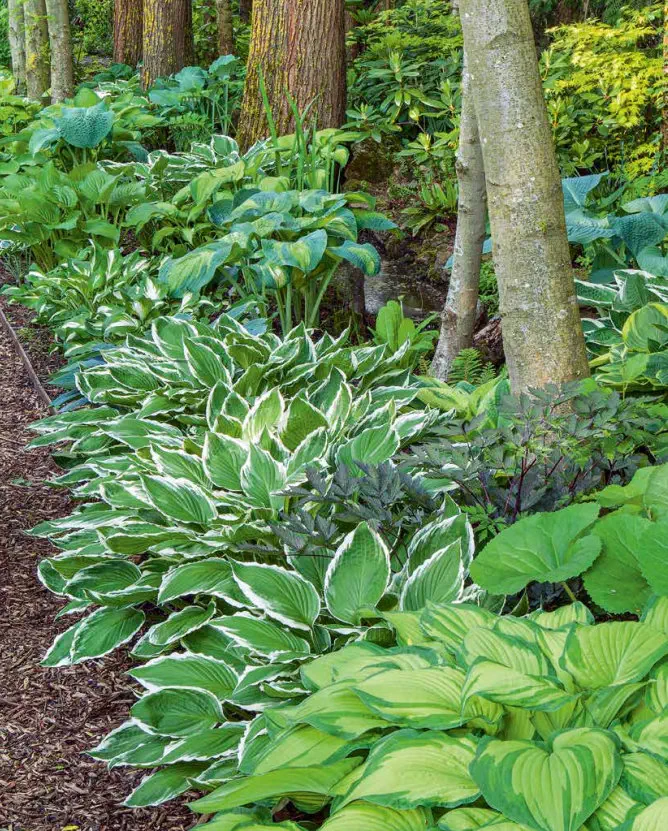 The ‘big boys’ are useful for adding impact to mixed plantings and also as stand-alone specimens. Some have leaves 45cm (18in) or wider across and can form clumps to 1.5m (5ft) or more in height and spread. Hosta ‘Empress Wu’, with its blue-green foliage, is perhaps the largest cultivar of all but for variegated foliage, its similarly sized sport ‘Wu-La-La’ has leaves with apple-green margins. Other large cultivars worth a look are popular bluish ‘Frances Williams’ AGM and ‘Sea Beacon’ 6 , a cultivar with good presence; if that its way into my top 10, is big with the large, rounded leaves and pale green of its ‘Sum and Substance’ AGM parentage, but with an added almost-white edging.
The ‘big boys’ are useful for adding impact to mixed plantings and also as stand-alone specimens. Some have leaves 45cm (18in) or wider across and can form clumps to 1.5m (5ft) or more in height and spread. Hosta ‘Empress Wu’, with its blue-green foliage, is perhaps the largest cultivar of all but for variegated foliage, its similarly sized sport ‘Wu-La-La’ has leaves with apple-green margins. Other large cultivars worth a look are popular bluish ‘Frances Williams’ AGM and ‘Sea Beacon’ 6 , a cultivar with good presence; if that its way into my top 10, is big with the large, rounded leaves and pale green of its ‘Sum and Substance’ AGM parentage, but with an added almost-white edging.
Hostas are good companion plants and work well among ferns and other woodland plants. Grow them with narcissi, tulips and other bulbs: as they come up over these areas they negate the need to tidy up is too big and bold, ‘Robert Frost’ has similar dying bulb vegetation, letting the bulbs reabsorb markings but probably not as much cream. Hosta ‘Winter Snow’ AGM, a new introduction fast making nutrients. There should be room for a variegated selection or two in most UK gardens.
Nurseryman Colin Ward’s guide to protecting your plants from slugs and snails
Hostas are easy to grow: as a rule they are not too prone to disease and will grow in most good soils and potting composts. Slugs and snails are the main pests, and are likely to need controlling.
 Organic and cultural controls: molluscs travel on a film of slime, so barrier prevention is a popular organic control method. These include wool, eggshells, sharp flint, garlic granules, pet hairs and bran applied as mulches around plants (although not found effective in RHS trials). We also use garlic spray, fortnightly: it works either by masking plants’ scent or making them unpalatable. Grown in pots, plants can be made inaccessible to molluscs with water or mulch barriers, but do not place pots next to walls. Copper tape around pots is recommended but we use a smearing of Vaseline round the edge of pots with salt mixed in it. Beer traps can be effective, and black plastic with a bit of raw liver under it can draw slugs overnight: check and dispose of those caught in traps in the morning.
Organic and cultural controls: molluscs travel on a film of slime, so barrier prevention is a popular organic control method. These include wool, eggshells, sharp flint, garlic granules, pet hairs and bran applied as mulches around plants (although not found effective in RHS trials). We also use garlic spray, fortnightly: it works either by masking plants’ scent or making them unpalatable. Grown in pots, plants can be made inaccessible to molluscs with water or mulch barriers, but do not place pots next to walls. Copper tape around pots is recommended but we use a smearing of Vaseline round the edge of pots with salt mixed in it. Beer traps can be effective, and black plastic with a bit of raw liver under it can draw slugs overnight: check and dispose of those caught in traps in the morning.
Biological control: nematodes work well on slugs – because they retreat underground, where the nematodes can be absorbed – but seem less effective against snails.
Chemical controls: we avoid using slug pellets on the nursery, but some gardeners may wish to continue with them as a last resort. Those based on metaldehyde are being withdrawn, but less toxic ferrous-based formulations will still be available.
We start using mollusc measures from February/March. Mid-season, fresh attacks on hostas usually coincide with flower emergence – their flowers have a slight rotting vegetation scent that is undetectable to us but not to molluscs. So, if flowers are inconsequential, removing them may reduce slug and snail damage. We also remove all dead hosta vegetation at the end of the season so it does not provide food for hibernating slugs and snails.



